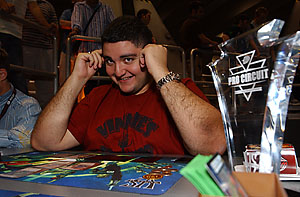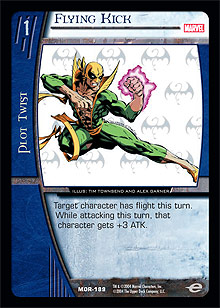
Before I go into my article, let me introduce myself. My name is Antonino De Rosa and I have been playing TCGs professionally for about three years. Some of you know me from my two lucky PC Top 8s, and some of you know me as the big idiot who was reading Alfred Pennyworth in the Top 8 of PC NY.
 TCGs are the best thing that has ever happened to me. They helped me pay my way through college. I have traveled all around the world and met my closest and dearest friends while competing in TCG tournaments. But the greatest thing that has happened to me because of TCGs is getting employed by Upper Deck Entertainment. I am contracting for the Vs. System R&D department, and let me tell you, it’s a blast. My coworkers are awesome and I get to do what I love every day—play games.
TCGs are the best thing that has ever happened to me. They helped me pay my way through college. I have traveled all around the world and met my closest and dearest friends while competing in TCG tournaments. But the greatest thing that has happened to me because of TCGs is getting employed by Upper Deck Entertainment. I am contracting for the Vs. System R&D department, and let me tell you, it’s a blast. My coworkers are awesome and I get to do what I love every day—play games.
I want to warn everyone . . . I’ve never written an article before that just highlights basic concepts of a game, but my target audience today is beginners who are trying to qualify for the Pro Circuit or who have just started playing. I have written a few strategy pieces on VSuniverse.com about the metagame, how to fix certain decks, and what decks to play at any specific tournament. But since I am now a part of R&D, it’s no longer my place to write pieces like that; I don’t want to influence the metagame at all, and more importantly, I shouldn’t influence anyone’s decisions about what deck to play at a given event.
I will try very hard to write as often as bi-weekly. If you like my articles or have topic suggestions, you can send me a note at Italiano1981@hotmail.com.
This week, I will talk about when to use a plot twist. This might be as hard as brain surgery or as easy as smashing a pizza—it all depends on board position and endurance totals. Many new players have trouble figuring out the right time to use their ATK and DEF pumps. While playing, you have to ask yourself, “Am I forcing or saving a stun?” These questions seem basic and easy to understand, but it’s not as cut and dry as you may think.
The first things you have to figure out are which fights you want to commit yourself to. People love getting involved in huge wars over a 2- or 3-drop. Well, is it worth losing all your tricks on turn 3 just so you can go into turn 4 with one more drop than your opponent? Are you ready to lose your turn 3 play because you don’t have more plot twists, and then go into turn 5 with your 2- and 4-drop against your opponent’s 4- and 3-drop?
 The next thing you have to figure out is what you’re gaining. How will your board position improve or get worse based on this plot twist? Let’s say you and I are each playing a Curve deck. You have out a 2 ATK / 2 DEF character and a 4 ATK / 4 DEF character. I have out two 3 ATK / 3 DEF characters. You can use a Flying Kick or a Blown to Pieces (depending on the initiative) to force a double stun on my characters. On turn 4, you have a 2 ATK / 2 DEF character, a 4 ATK / 4 DEF character, and a 7 ATK / 7 DEF character. I have a 3 ATK / 3 DEF character left and have just played my own 7 ATK / 7 DEF character. I attack the 3 ATK / 3 DEF character into your 2 ATK / 2 DEF character. Then I take my 7 ATK / 7 DEF into your 4 ATK / 4 DEF and even out the board position without using any plot twists. I basically sacrificed some number of endurance for card advantage. I know that, in the crucial turns of the game when the fight will really matter (around turns 5, 6, or 7), my opponent will have one less plot twist.
The next thing you have to figure out is what you’re gaining. How will your board position improve or get worse based on this plot twist? Let’s say you and I are each playing a Curve deck. You have out a 2 ATK / 2 DEF character and a 4 ATK / 4 DEF character. I have out two 3 ATK / 3 DEF characters. You can use a Flying Kick or a Blown to Pieces (depending on the initiative) to force a double stun on my characters. On turn 4, you have a 2 ATK / 2 DEF character, a 4 ATK / 4 DEF character, and a 7 ATK / 7 DEF character. I have a 3 ATK / 3 DEF character left and have just played my own 7 ATK / 7 DEF character. I attack the 3 ATK / 3 DEF character into your 2 ATK / 2 DEF character. Then I take my 7 ATK / 7 DEF into your 4 ATK / 4 DEF and even out the board position without using any plot twists. I basically sacrificed some number of endurance for card advantage. I know that, in the crucial turns of the game when the fight will really matter (around turns 5, 6, or 7), my opponent will have one less plot twist.
I know that a lot of these situations have to do with flying and formations, but that’s for a different article; let’s just assume that we are playing Green Lantern and everything flies. Planning ahead and picking your battles is something that will come more naturally the more you play. It’s hard to determine on turn 3 when the game will end, but in the later turns, you should be able to figure out and plan the turn when you want this to happen. Saving your plot twists for the last couple of turns of the game is very important.
 The next thing you have to figure out is whether playing this Acrobatic Dodge (for example) now will save you more than 3 endurance. Let me explain: Let’s say it’s turn 6, and you have out a 9 ATK / 9 DEF character and a 12 ATK / 12 DEF character. It’s your opponent’s initiative. He has out a 10 ATK / 10 DEF character and a 12 ATK / 12 DEF character. He attacks his 12 ATK / 12 DEF character into your 12 ATK / 12 DEF character to force a double stun. He then takes his 10 ATK / 10 DEF character into your 9 ATK / 9 DEF character. You can save your Acrobatic Dodge for later to save you 3 endurance and a bigger stun. But if you play it right now, you will save yourself more than 6 endurance. You save your guy from stunning (5 endurance loss), plus you save yourself 1 breakthrough. You’ll also save yourself endurance loss on the next turn, since you will have the same number of characters on turn 7 as your opponent.
The next thing you have to figure out is whether playing this Acrobatic Dodge (for example) now will save you more than 3 endurance. Let me explain: Let’s say it’s turn 6, and you have out a 9 ATK / 9 DEF character and a 12 ATK / 12 DEF character. It’s your opponent’s initiative. He has out a 10 ATK / 10 DEF character and a 12 ATK / 12 DEF character. He attacks his 12 ATK / 12 DEF character into your 12 ATK / 12 DEF character to force a double stun. He then takes his 10 ATK / 10 DEF character into your 9 ATK / 9 DEF character. You can save your Acrobatic Dodge for later to save you 3 endurance and a bigger stun. But if you play it right now, you will save yourself more than 6 endurance. You save your guy from stunning (5 endurance loss), plus you save yourself 1 breakthrough. You’ll also save yourself endurance loss on the next turn, since you will have the same number of characters on turn 7 as your opponent.
People have a misconception about offensive and defensive pumps. A defensive pump can be used as an offensive card, and vice versa. In the example above, not only did the Acrobatic Dodge save you lots of endurance, but it also allowed you to have a 9 ATK / 9 DEF character on your initiative to attack with.
Plot twists are used for many things. They help you to achieve board advantage (by allowing you to have more guys in play than your opponent), they save endurance, and they allow you to deal more damage. Using them is not cut and dry because an offensive plot twist is more than just an offensive plot twist, just as an Acrobatic Dodge is more than just a defensive modifier.
The last thing I want to talk about are restrictive plot twists and power-ups that don’t get used. The game we love is all about endurance, and it’s not uncommon to win or lose by 1. Maximizing the damage you deal and minimizing the damage you take each turn is key. To that end, let’s look at one common mistake that I see often and of which I myself have been guilty.
On turn 4, your 7 ATK / 7 DEF character is stunned. Your opponent’s 6 ATK / 6 DEF 3-drop attacks your 4 ATK / 4 DEF 3-drop. You have a power-up. You will lose the 3-drop for sure because you’re planning to recover the 7 ATK / 7 DEF character. You have no discard effects in your deck. You should power-up to save an endurance point, and you should do the same thing with plot twists. Let’s say that you know the game will end on turn 7. On turn 6, if you have the initiative, you should use every offensive plot twist you have to deal the most possible damage. If your opponent has the initiative, you should use all of your Cover Fires and Acrobatic Dodges, because it’ll be the last turn that you can use them (on turn 7, you will be the one attacking).
I really hope you guys enjoyed this article. I have the next few articles planned out: formation, deckbuilding, mulliganing, and team attacking/reinforcing. Hopefully, all the advanced players out there will give me a little slack and won’t call me “Captain Obvious.” For all the beginners out there, I hope I have helped to make your exploration and mastering of the game we all love a more enjoyable and fun experience. As I mentioned earlier, if you have suggestions about what you want to read, I’m glad to listen and help in any way possible.
’Til next time . . .
Cheers,
Antonino De Rosa